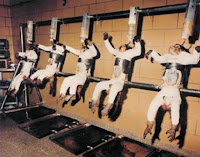Week 1: Two Cultures
I often feel ashamed when I tell people what my major is. The conversation usually ends with them saying it’s just “a fun major”. Though this never offends me because I know how great being a dance major really is. I know they don’t intentionally mean to come off in a rude way, but those types of interactions show me what little people may think of dance. Sometimes I feel like being a dance major makes me look like I’m less intelligent than those on the other side of campus, but that’s completely mistaken.
https://goo.gl/images/TXQaij
After the introduction of the two cultures, by CP Snow in
his lecture, I am now starting to see how much dance and science are connected
in my experiences. In a way I feel like I am helping pave the way for the third
culture that we have read about. Looking back at all my prior dance classes
here at this university, I am realizing the ways that dance has supported
science and science supported dance. Not only have I explored some paths of
dance science, but looking at dances and seeing the aspects of science that it
holds. Like this ball passing video, this work of art takes paths and patterns
to make the entire machine work. Not only does the dance entirely reference one’s
genes and organs in the body, but when I watch it, it actually reminds me of
what a gene or chromosome looks like.
https://www.youtube.com/watch?v=-3RLceywn8E
This first week has opened my eyes to see my major in an
entirely new perspective. The greatest part of it is that it was always right
there in front of me, I just needed more information and knowledge to finally
see how the arts and science can either have a gap, or be connected.
Palace -. "What Contemporary Dance Has in Common with Science."Rambert. N.p., 16 Sept. 2015. Web. 10 Apr. 2017.
Staff, Tell Me More. "Teaching Science Through Hip Hop." NPR. NPR, 04 Nov. 2013. Web. 10 Apr. 2017.
Trinity Laban Conservatoire of Music and Dance." Dance Science | Trinity Laban. N.p., n.d. Web. 10 Apr. 2017.
Charis-Carlson, Jeff. "Connecting Science and Dance in 'the New Age of Humans'." Iowa City Press-Citizen. N.p., 06 Mar. 2015. Web. 10 Apr. 2017.
"What Do Street Dance and Ballet Have in Common?" UMS. N.p., n.d. Web. 10 Apr. 2017.




Hi Kulia,
ReplyDeleteI completely agree with the existence of those polarizing stereotypes, the same ones Dr. Vesna refers to in lecture, at the UCLA campus. I love how you are breaking those doors by creating that third culture with your outlook on merging dance and science. It was great to here, especially from your background, how those disciplines overlap in innovative ways like dance science and are rather dependent on each other. As a bioengineer, I felt like I learned just as much as I did in my technical classes as I did with my dance major and sociology major roommates on how to view the world with different perspectives. I especially love the idea of everything or everyone "working together" as you and the video you posted mentioned. This concept that there are so many parts that must connect in a way for perfect harmony reminds me now not only of human physiology, in how our organs work together, but also dance, in patterns and choreography.
Hi,
ReplyDeleteI never realised how much correlation do these two totally different fields have until I saw your post. The idea of two cultures has made me realise that I have so much more to learn about how seemingly different fields are inter related and ignoring this just makes people more distant to each other every day.